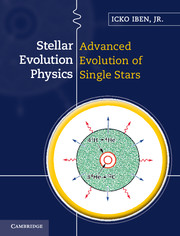Book contents
- Frontmatter
- Contents
- Preface
- Part IV Transport processes, weak interaction processes, and helium-burning reactions
- 12 Particle diffusion and gravitational settling
- 13 Heat conduction by electrons
- 14 Beta decay and electron capture in stars at high densities
- 15 Current–current weak interactions and the production of neutrino–antineutrino pairs
- 16 Helium-burning nuclear reactions and energy-generation rates
- Part V Evolution during helium-burning phases
- Part VI Terminal evolution of low and intermediate mass stars
- Index
- References
12 - Particle diffusion and gravitational settling
from Part IV - Transport processes, weak interaction processes, and helium-burning reactions
Published online by Cambridge University Press: 05 December 2012
- Frontmatter
- Contents
- Preface
- Part IV Transport processes, weak interaction processes, and helium-burning reactions
- 12 Particle diffusion and gravitational settling
- 13 Heat conduction by electrons
- 14 Beta decay and electron capture in stars at high densities
- 15 Current–current weak interactions and the production of neutrino–antineutrino pairs
- 16 Helium-burning nuclear reactions and energy-generation rates
- Part V Evolution during helium-burning phases
- Part VI Terminal evolution of low and intermediate mass stars
- Index
- References
Summary
In constructing models of evolving stars in volume 1 of this monograph, it has been assumed that particle diffusion can be neglected. However, the current abundance of Li at the solar surface is much smaller than predicted by models neglecting diffusion and this suggests that, during the gravitationally contracting phase which preceeds the main sequence, diffusion carries Li from the convective envelope into higher temperature regions below the base of the envelope where it can be destroyed. The abundance of Fe observed at the solar surface is smaller than the interior Fe abundance indicated by comparison between neutrino fluxes observed from the Sun and fluxes predicted by solar models, suggesting that Fe has diffused out of the convective envelope during the main sequence phase into regions below the base of the convective envelope. The fact that many low luminosity white dwarfs exhibit monoelemental surface abundances is a dramatic demonstration that, in regions where the gravitational acceleration is orders of magnitude larger than near the surface of the Sun, gravitationally induced diffusion is a first order effect. Thus, there is ample motivation for studying the physics of diffusion.
A description of the physics of particle diffusion can be given on many levels of sophistication. The description adopted in this chapter is based on an analysis of Boltzmann transport equations constructed on the assumptions that there exists an equilibrium distribution function for every species of particle and that, when a system is not in equilibrium, the time rate of change of each distribution function can be determined as the consequence of binary interactions between all particles.
- Type
- Chapter
- Information
- Stellar Evolution Physics , pp. 893 - 940Publisher: Cambridge University PressPrint publication year: 2012



